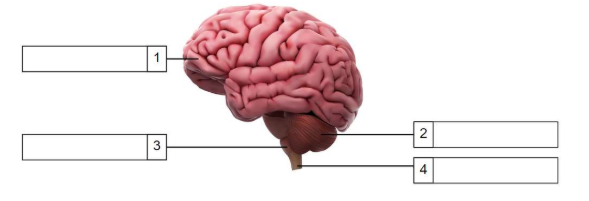Nervous System
1/55
There's no tags or description
Looks like no tags are added yet.
Name | Mastery | Learn | Test | Matching | Spaced |
|---|
No study sessions yet.
56 Terms
What is the function of the nervous system?
Transmits nerve impulses between different parts of the body
What are the main components of the nervous system?
Nerves, brain, spinal cord and sensory organs
Which components are part of the central nervous system?
The nerves and the brain
Which components are part of the peripheral nervous system?
The spinal cord and the sensory organs
What does peripheral mean?
outside
Where is the peripheral system located?
It is outside of the central nervous system
What does the peripheral system do?
It connects the central nervous system to the muscles and organs
What is the brain protected by?
The skull
What is the function of the brain?
It sends messages to the rest of the body and there are different areas with different functions
Where is the spinal cord located?
Inside the vertebral column
What does the spinal cord protect?
The bundle of nervous tissues and supports the cells
What is the fuction of the nerves?
Transmites messages from the brain and the spinal cord to the rest of the body and back
What are nerves?
An enclosed bundle of nerve cells called neurons
What does the nerves make up in the nervous system?
The nerve tissues
What is the stimuli?
It helps to detect dangers from our enviroment
Where does the stimuli form?
From outside the body
What is the enviroment detected by?
The sensory organs
What is the function of the sensory organs?
Detects dangers from our enviroment (stimuli)
What are the sensory organs of the body?
The ears, nose, eyes, skin and tongue
What are the main processes of the nervous system?
The body collects, sends and receives multiple messages from sources in the body
How is the nervous system transmitted?
As electrical signals along nerve cells (impulses)
How are impulses sent to your brain?
By nerve cells for interpretation
What are our senses?
Sight, touch, smell, hearing and taste
How are we able to hear sound?
Impulses travel along the auditory nerve to the brain. The brain then interpretes these impulses so that were are able to understand what we are hearing.
How are we able to see?
Light that is in our eyes are transmitted into impulses
Where do the impulses travel to?
The impulses travel along the optic nerve to the brain. The brain then interpretes these impulses so that we are able to see
What are receptors?
Nerve ending that cover the skin, muscles, bones, joints, internal organs and circulatory systems
How are we able to touch?
By receptors
What does touching respond to?
To pressure, pain, temperature and movement
What are we able to taste?
Sweet, sour, bitter, salty and umami
How are we able to taste?
By the taste buds on our tongues and parts of our mouth
Which sensory organs receptor’s work closely together?
The mouth and the nose?
Why do the receptor’s in our mouths and noses work closely together?
To send electrical impulses to the brain. The brain then interprets these impulses as different flavours
How are we able to smell?
By the receptors in the lining of our nose that respond to the molecules in the air.
Where do the receptors in the lining of your nose send impulses to?
The brain
What happens to the receptors in the lining of your nose that sends impulses to your brain?
The brain interprets the impulses and results in being able to recognize different smells
At what temperature must the human body be kept at?
37°C
How are the changes in the body temperature detected and controlled?
By the nervous system
What does the body do to cool down?
The body will start to sweat
What does the body do to warm itself?
The body will start to shiver
What are the health issues of the nervous system?
Strokes, degenerative diseases, mental heal problems, sensory organ problems, trauma and injuries to the brain and spinal cord and alcohol and drug abuse
What are the brain and skull protected by?
The skull and vertebral column
How are trauma and injuries caused?
Tissues in the central nervous system can be damaged by severe trauma and injuries
What are some examples of trauma and injuries?
Cars accidents
How could trauma and injuries come from a car accident?
If a person breaks their neck, the spinal cord could be damaged and the person could be paralyzed which connect the peripheral nervous system to the brain
How does damage to the spinal cord affect the nervous system?
It prevents the brain from sending and receiving messages to the body
What are strokes?
When blood flow to the brain is stopped. The blood clot deprives the brain from blood and oxygen which leads to a loss of brain function.
What are degenerative disorders?
Refers to conditions that cause a gradual loss of brain function over time
What are some examples of degenerative disorders?
Alzheimer’s disease, parkinson’s disease and multiple sclerosis
What are some examples of mental health problems?
Depression, anxiety disorders, personality disorders
How are sensory organs associated with the nervous system?
They receive stimuli from the environment
What problems could happen if something happened with the sensory organs?
Deafness, blindness and short sightedness
What happens to a person who consumes drugs and alcohol?
They could get addicted
Why do people who consume drugs and alcohol get addicted?
Because of the reactions that the products produce in the brain
What problems could happen to a person who consumes drugs and alcohol?
Irreversible brain damage, decreased learning capacity, loss of memory, increased risk of strokes and heart attacks and emotional and mental health problems

Write down numbers 1 - 4 naming the different parts of the brain
Frontal lobe
Cerebellum
Brain stem
Spinal cord